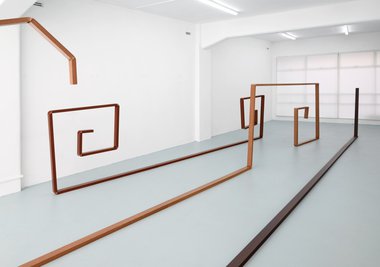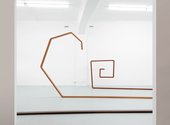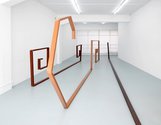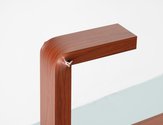John Hurrell – 13 October, 2023
Calculatedly shonky through being bent clumsily into configurations via a firm workshop vice, these wickedly ambiguous works seem to provocatively smirk at ‘correctional' post-colonial piety and virtue signalling. Their gangly forms and fake tacky materiality, in rendering well-known ‘Māori' imagery, prod you into looking at them askance.
With three, very minimal, skinny linear sculptures that look like ‘walk through’ drawings, Peter Robinson presents in this seemingly comical installation, references to traditional Māori design and elements such as waka shape and spiral motifs—using Knot-wood or Metwood, hollow aluminium beams covered in ersatz-wood vinyl veneer.
Calculatedly shonky through being bent clumsily into configurations via a firm workshop vice, these wickedly ambiguous works seem to provocatively smirk at ‘correctional’ post-colonial piety and virtue signalling. Their gangly forms and fake tacky materiality, in rendering well-known ‘Māori’ imagery, prod you into looking at them askance.
So a big question is raised: what is Robinson up to here? Is he being a rascal who is more than a little irritating with his ‘reckless’ use of these motifs—for he raises the issue: does art have to have a meaning, and if it does, what are the interpretive possibilities for this work, some speculations of which might cause consternation? The uncluttered, ‘throw-away’ and casual style of this sculpture seems very politically loaded, while the title implies nothing is ever fixed—but only ‘drifts’ around. Here are four possibilities.
One option is, is he firing shots at the so-called ‘Woke’ university-led art community he is normally considered a stalwart of, trying to tell them something they don’t want to hear about stylistic or cultural identity templates? Is he unhappy about the direction of Māori cultural branding (the defined attributes), and thinking that all assumptions of authenticity are dubious? Or past their use-by date?
Or is he instead aiming at something else, maybe satirising a vocal section of the seemingly gullible and resentful NZ /Aotearoa public who tomorrow will complete voting on the main political parties and members for a new Parliament? Is it possible he is attempting to use a deliberately ‘poor’ type of Māori imagery to generate a white backlash, baiting with what might be seen as meagre ‘uninspiring’ motifs, and arousing knee-jerk scorn and community fury—something to then easily lampoon?
Or is Robinson just being a scamp, a mischievous stirrer for stirring’s sake? Is he enjoying sparking off a little ideational and political chaos by making novel spidery images that by being less than rapturous, will cause a laugh with lovers of irony within the well-read art crowd? The simplest possibility of the four.
There might also be another angle, to boldly speculate even further: With his humorous use of general morphology and weedy demeanour, Robinson may (in this extrapolation) be addressing Māori specifically—especially fellow academics—saying that they shouldn’t be too earnest, and that they should loosen up about their heritage, and remove any strains of pomposity—without compromising on their culture’s profound uniqueness and obvious value? He could be proposing that they don’t become too hermetic and inward, but instead see themselves as representing one of many indigenous global communities that have values to offer to the planet? They shouldn’t exaggerate their own importance, even within the confines of Aotearoa.
Robinson‘s exhibition can be seen as obliquely issuing a kind of challenge for this country’s indigenous art forms and their proponents; one that at times encourages the possibility of second thoughts for artists, art historians, critics and cultural theorists, suggesting a consideration of the perhaps too-hidden legitimacy of doubt.
John Hurrell






 Two Rooms presents a program of residencies and projects
Two Rooms presents a program of residencies and projects Advertising in this column
Advertising in this column



This Discussion has 0 comments.
Comment
Participate
Register to Participate.
Sign in
Sign in to an existing account.